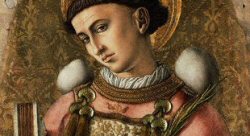
A Visible Sign: The Roman Collar
from Deo Juvante
The Directory for the Ministry and Life of Priests, prepared by the Congregation for the Clergy and approved by Pope John Paul II on January 31, 1994 has this to say:
In a secularized and tendentiously materialistic society, where even the external signs of sacred and supernatural realities tend to bedisappearing, the necessity is particularly felt that the priest-man of God, dispenser of His mysteries-should be recognizable in the sight of the community, even through the clothing he wears, as an unmistakable sign of his dedication and of his identity as arecipient of a public ministry. The priest should be recognizable above all through his behavior, but also through his dressing in away that renders immediately perceptible to all the faithful, even to all men, his identity and his belonging to God and to the Church.
When collars were quickly taken off a few decades ago, the common argument proclaimed was, "What's really important is what's inside me . . . I don't need an article of clothing to define my priesthood".
Let us examine the importance of the Roman Collar.
The Roman Collar is a clerical collar that should be worn by all ranks of clergy. Bishops, priests, transitional deacons, and seminarians who have been admitted to candidacy for the priesthood (as is the case in the Diocese of Rome and many other Seminaries throughout the world). Apart from entirely exceptional circumstances, the non-use of clerical clothing on the part of the cleric can manifest a weak sense of his own identity as a pastor completely dedicated to the service of the Church.
Rev. Ken Collin's, explains that "clothing conveys a message. A business suit says, 'Money!' A police uniform says, 'Law!' A tuxedo says, 'Wedding!' Casual clothing says, 'Me!' Clericals say, 'Church!' "
A priest is never 'off-duty' when he puts on the Roman Collar. Any occassion he is in can be turned into a pastoral ministry. Whenever a priest has his collar one, he no longer needs words to explain his presence. It is unlikely that anyone would stop a Roman Catholic priest with his collar on from entering a hospital after visiting hours or bar him from crossing the yellow tape at an accident scene.
A priests' ministry is unending and there are no definate working hours. Casualness about being publicly identified as a priest of the Catholic Church may signify a desire to distance himself from his priestly vocation. The collar becomes 'workclothes,' which are put away when one is not 'on duty.' The functionalistic notion of the priesthood revealed by this attitude is in contradiction to the ontological configuration to Christ the High Priest conferred by priestly ordination. Furthermore, to have a 'split personality' is never healthy. No priest can temporarily put his priesthood on the shelf.
With this visible symbol of his sacred ministry around his neck, the priest allows the faithful to approach him no matter where he is; be it at the cafe having his morning cuppa or at the grocers picking up some provisions.
A person can make a confession and be reconcilled to God, a young teen may ask a quick question about the faith and be strengthened, an lost soul may come up to the priest and ask, “Father, what must I do to inherit eternal life?”, a businessman may receive a blessing before his flight, etc... Christ's faithful (and even those outside the fold) deserve nothing less. Lay people depend on their priests for spiritual support andstrength. They feel that something is not right when their priests try to blend into the crowd and, as it were, disappear.
Many priests often say that their people are adverse to the Collar. Well, trying to 'blend-in' isn't really the solution. Allowing the reactions of others affect the priest's decision to wear the collar is only allowing the problem to fester unresolved. Could it be that some think that what the collar signifies- Jesus Christ, the Catholic Church, the priesthood- are obstacles? Priests must relate to others as priests, never in spite of being priests.
"A white collar on a priest's neck should remind him of a ring and collar - his marriage to Christ and to the Church and giving his freedom to Christ, thus letting him control his life. We, priests, wear a collar because we want to be directed by Christ in all things. Please notice that our collars are white as opposed to our cassocks. In the background of a black robe it is a symbol of the light of resurrection. We go through the world giving up baubles and colours, living the hope of participation in the brightness of resurrection. This white collar in the background of our black dress is actually a sign of our desires and aspirations." Rev. Fr. Andrzej Przybylski.
We use symbols all the time, and need not be embarrassed by them. To obediently and humbly wear the collar expresses one's submission to the authority of God and his Holy Church.
Dear Rev. Fathers, please display the desire to manifest the presence of the Savior to a world gone mad... The reward is to be able to lead others to Christ is significant. Be aware that the priestly work you now do will not suffer but will be enhanced when you dress according to the venerable custom of the Church.
References & Acknowledgements:
'Why a Priest Should Wear His Roman Collar' by Reverend Gerald E. Murray.
The Directory for the Ministry and Life of Priests, prepared by the Congregation for the Clergy and approved by Pope John Paul II on January 31, 1994.
'Why Clergy Should Wear Clericals' by Reverend Ken Collins.























3 comments:
Some time ago, after 5+ years away from the Church and the sacraments, I was at a wedding reception where the grooms great-uncle, a retired priest, was also in attendance. Wearing his collar.
If he hadn't been wearing that, I might not have started talking to him. If he and I had not started talking, I would not have dragged him to an empty room of the reception hall to make my first confession in over 7 years.
Wear your collars!
"The Roman Collar is a clerical collar that should be worn by all ranks of clergy. Bishops, priests, transitional deacons, and seminarians who have been admitted to candidacy for the priesthood."
Hmmm . . . yet again the "permanent" Deacon, who is just as much a Deacon as one in the "transitional" state, is rendered a second-class citizen. Ironic that you had to even write this article to get priests to wear their collars while Deacons in the permanent state are desiring to live our their vocations to the clerical life fully by having the right to wear the Roman collar to be accessible to more of the faithful. Instead, we are relegated to dressing like undertakers or tax salesmen!
Tom, It seems to vary from Diocese to Diocese. In some Diocese Permanent Deacons are required to wear clerical dress if they are doing anything related to their ministry. Still in others, Deacons are absolutely forbidden to wear clerical dress, except in rare circumstances as approved by the Bishop or Director of the Permanent Diaconate. It seems the irrational fear is that deacons are going to wear their collars to work (IBM, Lowe's Home Improvement, etc.) or that they'll run around town with wife and family creating scandal.
This last point is of course ridiculous because any number of protestant ministers are running around these days in clerical dress and no one can tell anyone apart. Not too long ago a couple of us saw a husband and wife BOTH in clerical collars. To their credit they were witnessing to Christ by their dress, unlike the thousands of Permanent Deacons in the US who are not allowed to.
This ultimately may have to be addressed by the Congregation for Clergy. Notice there is no official Church document (from the Vatican) that strictly forbids permanent deacons from wearing clerical dress. All we have in the United States is a vague statement from the USCCB that does not explicitly say deacons can not wear clerical dress, but is widely interpreted as law.
Post a Comment